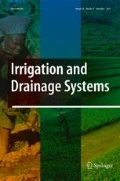Abstract
Drought and fresh water shortage are in the way of sustainable agriculture development in the North China Plain. The scarcity of fresh water forces farmers to use shallow saline ground water, which helps to overcome drought and increase crop yields but also increases the risk of soil salinization. This paper describes salt regimes and crop responses to saline irrigation water based on field experiments conducted from October 1997 to September 2005. It was found that use of saline water causes the ECe of the topsoil (0–100 cm, Cv: 0.196∼0.330) to be higher and more variable than the subsoil (100–180 cm, Cv: 0.133∼0.219). The salt load rapidly increased, notably in the upper 80 cm and especially during the season of October 1999 to June 2000. It was concluded that the maximum soil depth to which the soil was leached during the wet season was about 150 cm. The relative yields of winter wheat could be ranked Fresh Sufficient (FS, 100%) > Fresh Limited (FL, 91.80%) > Saline Sufficient (SS, 91.63%) > Saline Limited (SL, 88.28%) > Control (C, 69.58%) and for maize FS (100%) > FL (96.37%) > SS (93.05%) > SL (90.04%)> C (89.81%). The best irrigation regime was Saline Limited for winter wheat and maize, provided rainfall is sufficient. The experiments confirm that saline irrigation water appears to be economically attractive to farmers in the short term and ecological hazards can still be controlled with proper leaching.




Similar content being viewed by others
Abbreviations
- C:
-
Control
- FL:
-
Fresh Limited
- FS:
-
Fresh Sufficient
- JS:
-
the beginning of June to the end of September
- MM:
-
The beginning of March to the end of May
- OF:
-
The beginning of the October to the end of the following February
- SL:
-
Saline Limited
- SS:
-
Saline Sufficient
References
Beltran JM (1999) Irrigation with saline water: benefits and environmental impact. Agric Water Manag 40:183–194
Bresler E, McNeal BL, Carter DL (1982) Saline and sodic soils: principles dynamics-modeling. Springer, Berlin
Chen J (1988) Reducing the supply–require contradiction by exploitation the slightly saline water. Irrig Drain Syst 7:17–20
Fang S, Chen X (1997) Using shallow saline groundwater for irrigation and regulation for soil salt-water regime. Irrig Drain Syst 11:1–14
Fang S, Wolter HW (1993) The “four water” concept in China. GRID Issue 2
Kaledhonkar MJ, Keshari AK (2006) Modelling the effects of saline water use in agriculture. Irrig Drain 55:177–190
Monreno F, Cabrera F, Fernanadez-Boy E et al (2001) Irrigating with saline water in the reclaimed mash soils of south-west Spain: impact on soil properties and cotton and sugar beet crops. Agric Water Manag 48:133–150
Pang H, Yang J, Yan H (2004) Effects of irrigation with saline water on soil salinity and crop yield. Plant Nutr Fert Sci 10:599–603
Patel RM, Prasher SO, Goel PK et al (2003) Brackish water sub-irrigation for vegetables. Irrig Drain 52:121–132
Rhoades JD, Kandiah A, Mishali AM (1992) The use of saline waters for crop production. FAO, Rome
Shi Y, Jia D (1988) The map of the HuangHuai Hai plain. Beijing Agricultural University Press, Beijing
Shi Y, Xin D (1983) Movement of water and salt in soil and comprehensive control of drought, waterlogging, salinity and water in Huang-huai-Hai plain. Hebei People’s Publishing House, Shi Jiazhuang
Xiao Z (1995) The effects of irrigation water quality on water–salt dynamics. J Soil Sci 31:8–16
Xie C (1993) The principle of salt-affected soil improvement and crop salt tolerance. Beijing Agricultural University Press, Beijing
Xin J, Zhang G, Li Y (1986) A study on the correlation of different methods to measure soil salinity. In: Shi Y et al. (ed) Water and salt movement in saline soil. Beijing Agricultural University Press, Beijing
Yu Z (1990) Experimental study on using shallow saline groundwater for irrigation. In: Xin D et al. (ed) The integrated management and development of low production areas affected by shallow saline water. Beijing Agricultural University Press, Beijing
Acknowledgements
The authors are greatly indebted to the National Basic Research Program of China (2005CB121103) as well as to the SAIL Foundation of NUFFIC (SAIL-SPP 299.399), the Netherlands for the financial support given to this research. We furthermore like to thank two unknown reviewers and the editor for their valuable comments.
Author information
Authors and Affiliations
Corresponding author
Rights and permissions
About this article
Cite this article
Ma, W., Mao, Z., Yu, Z. et al. Effects of saline water irrigation on soil salinity and yield of winter wheat–maize in North China Plain. Irrig Drainage Syst 22, 3–18 (2008). https://doi.org/10.1007/s10795-007-9027-1
Received:
Accepted:
Published:
Issue Date:
DOI: https://doi.org/10.1007/s10795-007-9027-1




